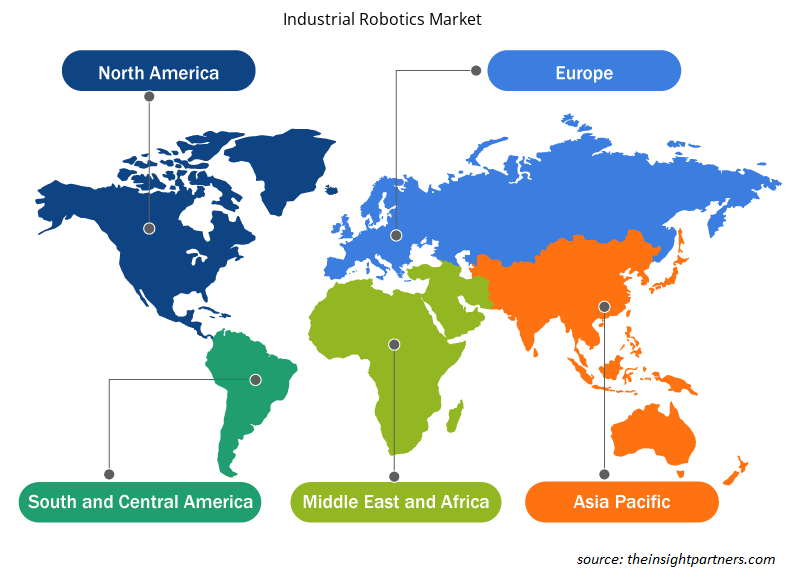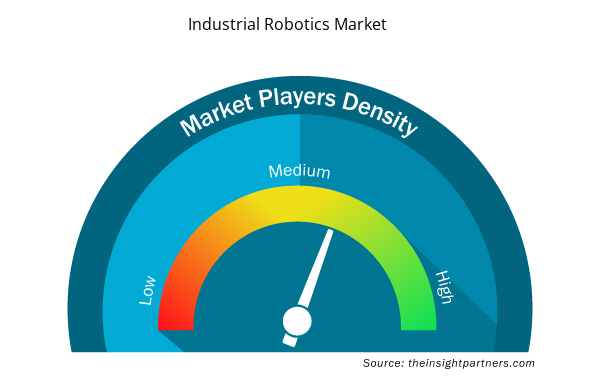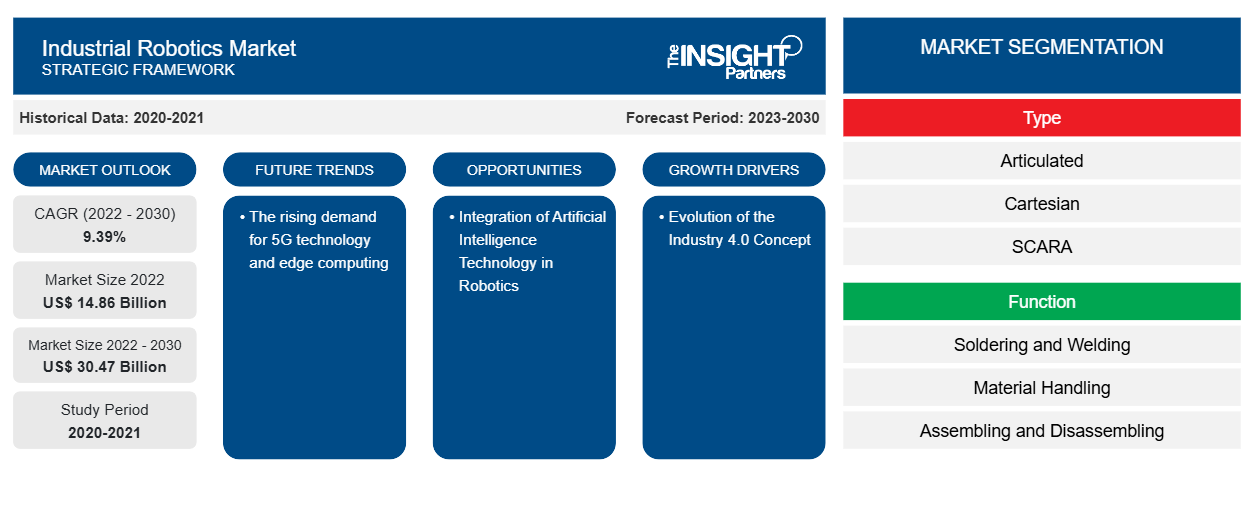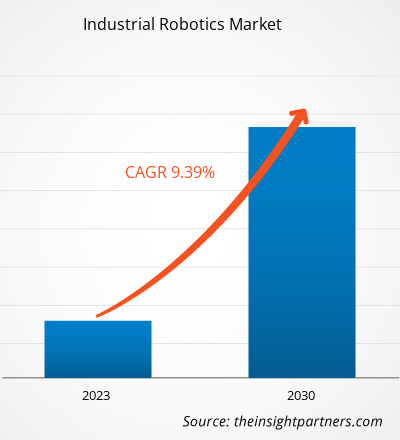Der Markt für Industrierobotik soll von 14,86 Milliarden US-Dollar im Jahr 2022 auf 30,47 Milliarden US-Dollar im Jahr 2030 anwachsen. Der Markt wird zwischen 2022 und 2030 voraussichtlich eine durchschnittliche jährliche Wachstumsrate (CAGR) von 9,39 % verzeichnen. Die steigende Nachfrage nach 5G-Technologie und Edge Computing dürfte weiterhin ein wichtiger Trend auf dem Markt bleiben.
Marktanalyse für Industrierobotik
Die Entwicklung des Industrie 4.0-Konzepts und die wachsende Nachfrage nach kollaborativen Robotern zur Steigerung der Betriebseffizienz treiben den Markt an. Aufgrund der steigenden Nachfrage nach Automatisierung in der Fertigungs-, Lager- und Logistikbranche wird für den Prognosezeitraum ein Marktwachstum erwartet. Darüber hinaus schafft die Integration künstlicher Intelligenz in die Robotik lukrative Möglichkeiten für den Markt.
Marktübersicht für Industrierobotik
Industrieroboter können als Roboterarme definiert werden, die mit Sensoren und Steuerungen ausgestattet sind und bei der Herstellung von Industrieprodukten eine Vielzahl von Funktionen und Vorgängen ausführen können. Sie sind so programmiert, dass sie sich wiederholende Aufgaben in Zyklen ausführen. Diese Roboter reduzieren den menschlichen Faktor bei der Produktion drastisch und erhöhen gleichzeitig die Verarbeitungsgeschwindigkeit, Qualität und Produktionskapazität. Die wichtigste Komponente des Roboters ist zweifellos der Arm, der aus Gelenken und Verbindungen besteht. Das End-of-the-Arm-Tool (EOAT) ist die wichtigste Komponente des Roboterarms. Sie übernehmen eine Vielzahl von Aufgaben, darunter Markieren, Schneiden, Schweißen, Bohren, Lackieren und Reinigen.
Passen Sie diesen Bericht Ihren Anforderungen an
Sie erhalten kostenlos individuelle Anpassungen an jedem Bericht, einschließlich Teilen dieses Berichts oder einer Analyse auf Länderebene, eines Excel-Datenpakets sowie tolle Angebote und Rabatte für Start-ups und Universitäten.
- Holen Sie sich die wichtigsten Markttrends aus diesem Bericht.Dieses KOSTENLOSE Beispiel umfasst eine Datenanalyse von Markttrends bis hin zu Schätzungen und Prognosen.
Treiber und Chancen auf dem Markt für Industrierobotik
Entwicklung des Industrie 4.0-Konzepts zugunsten des Marktes
Industrie 4.0 bezeichnet die aktuelle industrielle Revolution, die durch Fortschritte in den Bereichen Robotik, Automatisierung und Internet der Dinge (IoT) vorangetrieben wird. Der Aufstieg der industriellen Fertigung und der künstlichen Intelligenz wird wahrscheinlich tiefgreifende Auswirkungen auf die Robotik haben. Die Industrie 4.0-Technologie ermöglicht neue Wartungsstrategien, autonome Roboter und kollaborative Robotertechnologien. Neue Wartungsstrategien und künstliche Intelligenz werden voraussichtlich erhebliche Auswirkungen auf Roboter haben. Industrieroboter und Industrie 4.0-Technologien haben das Potenzial, Unternehmen in den nächsten Jahren zu verändern, indem sie das Maschinenmanagement verbessern und früher manuelle Aufgaben automatisieren, was voraussichtlich das Wachstum auf dem Markt für Industrierobotik ankurbeln wird.IoT). The rise of industrial lot and
Integration künstlicher Intelligenz in die Robotik
KI treibt bemerkenswerte Fortschritte im Bereich Robotik und Automatisierung voran. Während sich KI in der Robotik weiterentwickelt und entwickelt, nutzen zahlreiche Branchen diese Spitzentechnologien, beispielsweise durch die Implementierung intelligent automatisierter Prozesse zur Unterstützung anspruchsvoller Datenerfassung und -analyse, die es Unternehmen, Dienstleistern und Herstellern ermöglichen, datengesteuerte Entscheidungen zu treffen, oder die Implementierung selbstlernender Roboter zur Erleichterung von Arbeitsabläufen und Aufgaben. Die Einführung KI-basierter selbstlernender Roboter dürfte im Prognosezeitraum Marktchancen schaffen.
Segmentierungsanalyse des Marktberichts für Industrierobotik
Wichtige Segmente, die zur Ableitung der Marktanalyse für Industrierobotik beigetragen haben, sind Typ, Funktion und Branche.
- Basierend auf dem Typ ist der Markt für Industrierobotik in Gelenkroboter, kartesische Roboter, SCARA-Roboter, kollaborative Roboter, parallele Roboter und andere unterteilt. Das Gelenkrobotersegment hatte im Jahr 2022 einen größeren Marktanteil.cartesian, SCARA, collaborative, parallel, and others. The articulated segment held a larger market share in 2022.
- Nach Funktion ist der Markt in Löten und Schweißen, Materialhandhabung, Montage und Demontage, Lackieren und Dosieren, Fräsen sowie Schneiden und Verarbeiten unterteilt. Das Segment Materialhandhabung hatte im Jahr 2022 einen größeren Marktanteil.
- Auf Branchenbasis ist der Markt in die Branchen Automobil, Medizin und Pharma, Elektrik und Elektronik, Gummi und Kunststoff, Metall und Maschinenbau sowie Lebensmittel und Landwirtschaft unterteilt. Das Segment Lebensmittel und Landwirtschaft hatte im Jahr 2022 einen größeren Marktanteil.
Marktanteilsanalyse für Industrierobotik nach geografischer Lage
Der geografische Umfang des Marktberichts für Industrierobotik ist hauptsächlich in fünf Regionen unterteilt: Nordamerika, Asien-Pazifik, Europa, Naher Osten und Afrika sowie Süd- und Mittelamerika.
Aufgrund der steigenden Nachfrage nach Industrierobotern wird für den europäischen Markt im Prognosezeitraum ein Wachstum erwartet. Die Zahl der Industrieroboterinstallationen stieg 2021 im Vergleich zu 2020 um 33 %. Im Jahr 2021 stieg der Einsatz von Industrierobotern in der Elektronikindustrie um 22 %, in der Automobilindustrie um 57 % und in der Metall- und Maschinenbauindustrie um 29 % im Vergleich zu 2020. Laut IFR gehörten China, Japan und Südkorea im Januar 2023 zu den fünf fortschrittlichsten Ländern in Bezug auf die jährliche Zahl der Industrieroboterinstallationen, wobei der chinesische Markt für Industrieroboter die höchste Entwicklung verzeichnete.
Regionale Einblicke in den Markt für Industrierobotik
Die regionalen Trends und Faktoren, die den Markt für Industrierobotik im Prognosezeitraum beeinflussen, wurden von den Analysten von Insight Partners ausführlich erläutert. In diesem Abschnitt werden auch Marktsegmente und Geografie für Industrierobotik in Nordamerika, Europa, im asiatisch-pazifischen Raum, im Nahen Osten und Afrika sowie in Süd- und Mittelamerika erörtert.

- Erhalten Sie regionale Daten zum Markt für Industrierobotik
Umfang des Marktberichts zur industriellen Robotik
| Berichtsattribut | Details |
|---|---|
| Marktgröße im Jahr 2022 | 14,86 Milliarden US-Dollar |
| Marktgröße bis 2030 | 30,47 Milliarden US-Dollar |
| Globale CAGR (2022 - 2030) | 9,39 % |
| Historische Daten | 2020-2021 |
| Prognosezeitraum | 2023–2030 |
| Abgedeckte Segmente | Nach Typ
|
| Abgedeckte Regionen und Länder | Nordamerika
|
| Marktführer und wichtige Unternehmensprofile |
|
Marktteilnehmerdichte: Der Einfluss auf die Geschäftsdynamik
Der Markt für Industrierobotik wächst rasant. Dies wird durch die steigende Nachfrage der Endnutzer aufgrund von Faktoren wie sich entwickelnden Verbraucherpräferenzen, technologischen Fortschritten und einem größeren Bewusstsein für die Vorteile des Produkts vorangetrieben. Mit der steigenden Nachfrage erweitern Unternehmen ihr Angebot, entwickeln Innovationen, um die Bedürfnisse der Verbraucher zu erfüllen, und nutzen neue Trends, was das Marktwachstum weiter ankurbelt.
Die Marktteilnehmerdichte bezieht sich auf die Verteilung von Firmen oder Unternehmen, die in einem bestimmten Markt oder einer bestimmten Branche tätig sind. Sie gibt an, wie viele Wettbewerber (Marktteilnehmer) in einem bestimmten Marktraum im Verhältnis zu seiner Größe oder seinem gesamten Marktwert präsent sind.
Die wichtigsten auf dem Markt für Industrierobotik tätigen Unternehmen sind:
- ABB Ltd
- Yaskawa Electric Corporation
- Nachi-Fujikoshi Corp
- Fuji Robotik
- KUKA AG
- Universal Robots AS
Haftungsausschluss : Die oben aufgeführten Unternehmen sind nicht in einer bestimmten Reihenfolge aufgeführt.

- Überblick über die wichtigsten Akteure auf dem Markt für Industrierobotik
Neuigkeiten und aktuelle Entwicklungen zum Markt für Industrierobotik
Der Markt für Industrierobotik wird durch die Erhebung qualitativer und quantitativer Daten aus Primär- und Sekundärforschung bewertet, die wichtige Unternehmenspublikationen, Verbandsdaten und Datenbanken umfasst. Nachfolgend sind einige der Entwicklungen auf dem Markt für Industrierobotik aufgeführt:
- ABB Ltd bekräftigte sein Engagement für einen seiner wichtigsten Kundenmärkte, die USA, indem es mit dem Bau der Erweiterung seines derzeitigen Hauptsitzes und Produktionswerks für Robotik in Auburn Hills, Michigan, begann. Das Projekt wird bis November 2023 abgeschlossen sein und voraussichtlich 20 Millionen US-Dollar kosten. Die Erweiterung wird 72 neue hochqualifizierte Arbeitsplätze in der Region schaffen, unterstützt durch einen leistungsabhängigen Zuschuss von 450.000 US-Dollar aus dem Michigan Business Development Program. (Quelle: ABB Ltd, Unternehmenswebsite, März 2023)
Marktbericht zur industriellen Robotik: Umfang und Ergebnisse
Der Bericht „Marktgröße und Prognose für Industrierobotik (2020–2030)“ bietet eine detaillierte Analyse des Marktes, die die folgenden Bereiche abdeckt:
- Marktgröße und Prognose für Industrierobotik auf globaler, regionaler und Länderebene für alle wichtigen Marktsegmente, die im Rahmen des Berichts abgedeckt sind
- Markttrends und Marktdynamiken für Industrierobotik wie Treiber, Einschränkungen und wichtige Chancen
- Detaillierte PEST/Porters Five Forces- und SWOT-Analyse
- Marktanalyse für Industrierobotik mit wichtigen Markttrends, globalen und regionalen Rahmenbedingungen, wichtigen Akteuren, Vorschriften und aktuellen Marktentwicklungen
- Branchenlandschaft und Wettbewerbsanalyse, einschließlich Marktkonzentration, Heatmap-Analyse, prominenten Akteuren und aktuellen Entwicklungen auf dem Markt für Industrierobotik
- Detaillierte Firmenprofile
- Historische Analyse (2 Jahre), Basisjahr, Prognose (7 Jahre) mit CAGR
- PEST- und SWOT-Analyse
- Marktgröße Wert/Volumen – Global, Regional, Land
- Branche und Wettbewerbsumfeld
- Excel-Datensatz


- Photo Editing Software Market
- Bio-Based Ethylene Market
- Biopharmaceutical Contract Manufacturing Market
- Portable Power Station Market
- Smart Parking Market
- Vessel Monitoring System Market
- GNSS Chip Market
- Trade Promotion Management Software Market
- Adaptive Traffic Control System Market
- Flexible Garden Hoses Market

Report Coverage
Revenue forecast, Company Analysis, Industry landscape, Growth factors, and Trends

Segment Covered
This text is related
to segments covered.

Regional Scope
North America, Europe, Asia Pacific, Middle East & Africa, South & Central America

Country Scope
This text is related
to country scope.
Häufig gestellte Fragen
The rising demand for 5G technology and edge computing to play a significant role in the global industrial robotics market in the coming years.
The key players holding majority shares in the global industrial robotics market are ABB Ltd, Yaskawa Electric Corporation, Nachi-Fujikoshi Corp, Fuji Robotics, KUKA AG, Universal Robotics AS, Honeybee Robotics, COMAU SPA, and Clearpath Robotics Inc.
The global industrial robotics market is expected to reach US$ 30.47 billion by 2030.
The global industrial robotics market is estimated to register a CAGR of 9.39% during the forecast period 2022–2030.
Asia Pacific dominated the industrial robotics market in 2022.
The evolution of the Industry 4.0 Concept and the growing demand for collaborative robots for enhancing operational efficiency are the major factors that propel the global industrial robotics market.
Trends and growth analysis reports related to Electronics and Semiconductor : READ MORE..
The List of Companies - Industrial Robotics Market
- ABB Ltd
- Yaskawa Electric Corporation
- Nachi-Fujikoshi Corp
- Fuji Robotics
- KUKA AG
- Universal Robotics AS
- Honeybee Robotics
- COMAU SPA
- Clearpath Robotics Inc
- Staubli International AG
The Insight Partners performs research in 4 major stages: Data Collection & Secondary Research, Primary Research, Data Analysis and Data Triangulation & Final Review.
- Data Collection and Secondary Research:
As a market research and consulting firm operating from a decade, we have published and advised several client across the globe. First step for any study will start with an assessment of currently available data and insights from existing reports. Further, historical and current market information is collected from Investor Presentations, Annual Reports, SEC Filings, etc., and other information related to company’s performance and market positioning are gathered from Paid Databases (Factiva, Hoovers, and Reuters) and various other publications available in public domain.
Several associations trade associates, technical forums, institutes, societies and organization are accessed to gain technical as well as market related insights through their publications such as research papers, blogs and press releases related to the studies are referred to get cues about the market. Further, white papers, journals, magazines, and other news articles published in last 3 years are scrutinized and analyzed to understand the current market trends.
- Primary Research:
The primarily interview analysis comprise of data obtained from industry participants interview and answers to survey questions gathered by in-house primary team.
For primary research, interviews are conducted with industry experts/CEOs/Marketing Managers/VPs/Subject Matter Experts from both demand and supply side to get a 360-degree view of the market. The primary team conducts several interviews based on the complexity of the markets to understand the various market trends and dynamics which makes research more credible and precise.
A typical research interview fulfils the following functions:
- Provides first-hand information on the market size, market trends, growth trends, competitive landscape, and outlook
- Validates and strengthens in-house secondary research findings
- Develops the analysis team’s expertise and market understanding
Primary research involves email interactions and telephone interviews for each market, category, segment, and sub-segment across geographies. The participants who typically take part in such a process include, but are not limited to:
- Industry participants: VPs, business development managers, market intelligence managers and national sales managers
- Outside experts: Valuation experts, research analysts and key opinion leaders specializing in the electronics and semiconductor industry.
Below is the breakup of our primary respondents by company, designation, and region:

Once we receive the confirmation from primary research sources or primary respondents, we finalize the base year market estimation and forecast the data as per the macroeconomic and microeconomic factors assessed during data collection.
- Data Analysis:
Once data is validated through both secondary as well as primary respondents, we finalize the market estimations by hypothesis formulation and factor analysis at regional and country level.
- Macro-Economic Factor Analysis:
We analyse macroeconomic indicators such the gross domestic product (GDP), increase in the demand for goods and services across industries, technological advancement, regional economic growth, governmental policies, the influence of COVID-19, PEST analysis, and other aspects. This analysis aids in setting benchmarks for various nations/regions and approximating market splits. Additionally, the general trend of the aforementioned components aid in determining the market's development possibilities.
- Country Level Data:
Various factors that are especially aligned to the country are taken into account to determine the market size for a certain area and country, including the presence of vendors, such as headquarters and offices, the country's GDP, demand patterns, and industry growth. To comprehend the market dynamics for the nation, a number of growth variables, inhibitors, application areas, and current market trends are researched. The aforementioned elements aid in determining the country's overall market's growth potential.
- Company Profile:
The “Table of Contents” is formulated by listing and analyzing more than 25 - 30 companies operating in the market ecosystem across geographies. However, we profile only 10 companies as a standard practice in our syndicate reports. These 10 companies comprise leading, emerging, and regional players. Nonetheless, our analysis is not restricted to the 10 listed companies, we also analyze other companies present in the market to develop a holistic view and understand the prevailing trends. The “Company Profiles” section in the report covers key facts, business description, products & services, financial information, SWOT analysis, and key developments. The financial information presented is extracted from the annual reports and official documents of the publicly listed companies. Upon collecting the information for the sections of respective companies, we verify them via various primary sources and then compile the data in respective company profiles. The company level information helps us in deriving the base number as well as in forecasting the market size.
- Developing Base Number:
Aggregation of sales statistics (2020-2022) and macro-economic factor, and other secondary and primary research insights are utilized to arrive at base number and related market shares for 2022. The data gaps are identified in this step and relevant market data is analyzed, collected from paid primary interviews or databases. On finalizing the base year market size, forecasts are developed on the basis of macro-economic, industry and market growth factors and company level analysis.
- Data Triangulation and Final Review:
The market findings and base year market size calculations are validated from supply as well as demand side. Demand side validations are based on macro-economic factor analysis and benchmarks for respective regions and countries. In case of supply side validations, revenues of major companies are estimated (in case not available) based on industry benchmark, approximate number of employees, product portfolio, and primary interviews revenues are gathered. Further revenue from target product/service segment is assessed to avoid overshooting of market statistics. In case of heavy deviations between supply and demand side values, all thes steps are repeated to achieve synchronization.
We follow an iterative model, wherein we share our research findings with Subject Matter Experts (SME’s) and Key Opinion Leaders (KOLs) until consensus view of the market is not formulated – this model negates any drastic deviation in the opinions of experts. Only validated and universally acceptable research findings are quoted in our reports.
We have important check points that we use to validate our research findings – which we call – data triangulation, where we validate the information, we generate from secondary sources with primary interviews and then we re-validate with our internal data bases and Subject matter experts. This comprehensive model enables us to deliver high quality, reliable data in shortest possible time.


 Holen Sie sich ein kostenloses Muster für diesen Bericht
Holen Sie sich ein kostenloses Muster für diesen Bericht